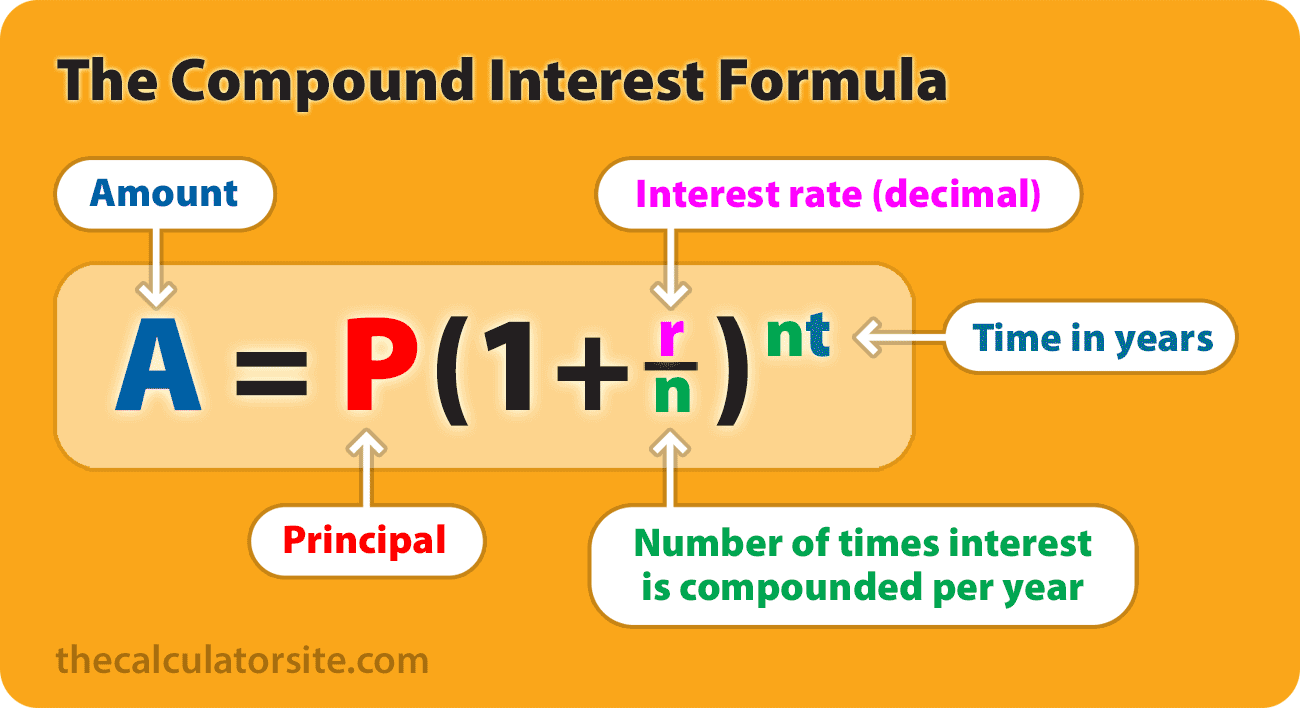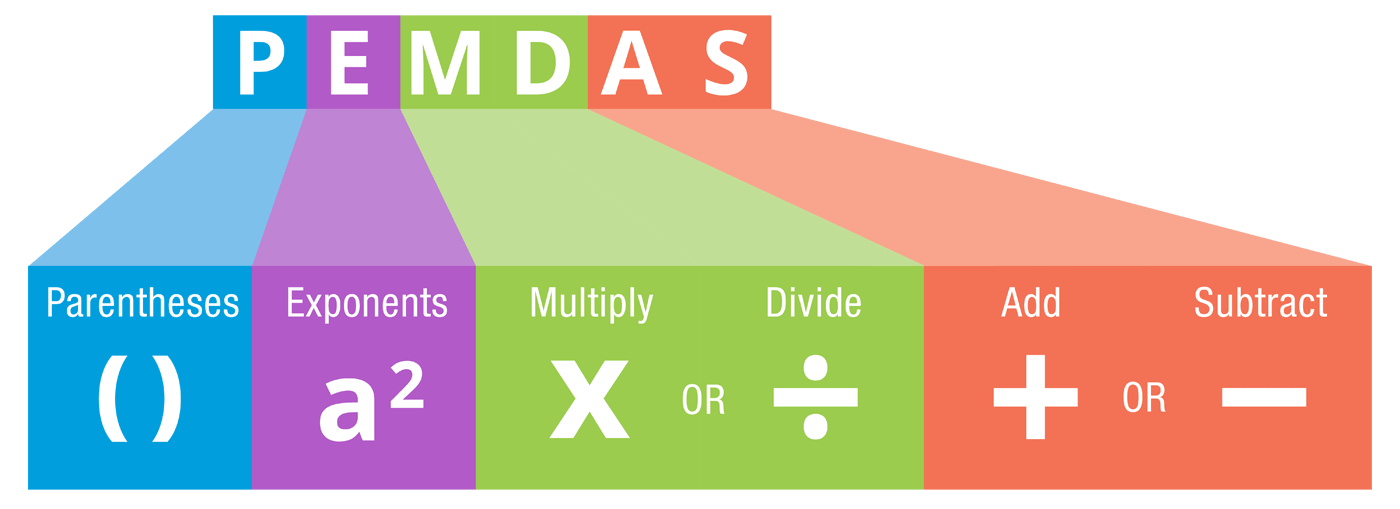

By Alastair Hazell . Reviewed by Chris Hindle .
Compound interest, or 'interest on interest', is calculated using the compound interest formula A = P*(1+r/n)^(nt) , where P is the principal balance, r is the interest rate (as a decimal), n represents the number of times interest is compounded per year and t is the number of years.
 compound interest formula: A = P(1 + r/n)^nt" width="" height="" />
compound interest formula: A = P(1 + r/n)^nt" width="" height="" />
To better understand the formula, let's create a simple example (we'll look into more complex variations, involving different compound intervals and extra contributions, later on in our article). Let's say that you invest $10,000 into a savings account for 20 years at an annual interest rate of 6%, compounded monthly. Here's how our calculation looks:
Plugging those figures into the formula, we can calculate as follows:
The investment balance after 20 years is therefore $33,102.04. If we check this figure using our compound interest calculator, we can see that we have calculated correctly.
In the following sections, we'll explore variations of the formula for annual, quarterly, monthly and daily compounding. We'll also provide a more detailed step-by-step explanation of how to use the formula and discuss how to it within an Excel spreadsheet.
To assist those looking for a convenient formula reference, I've included a concise list of compound interest formula variations applicable to common compounding intervals. Later in the article, we will delve into each variation separately for a comprehensive understanding.
Where:
In order to use the compound interest formula you will require specific values for your initial balance (principal), annual interest rate (expressed as a decimal), the number of compounds per year and the number of years you wish to calculate for. Let's take a look at how we put these into our formula.
Start by multiply your initial balance by one plus the annual interest rate (expressed as a decimal) divided by the number of compounds per year. Next, raise the result to the power of the number of compounds per year multiplied by the number of years. Subtract the initial balance from the result if you want to see only the interest earned.
The above set out as a formula is:
A = P(1 + r/n)^nt
Where:
It's worth noting that this formula gives you the future value of an investment or loan, which is compound interest plus the principal. Should you wish to calculate the compound interest only, you need to deduct the principal from the result. So, your formula looks like this:
Earned interest only (without principal)
Interest = P(1 + r/n)^nt - P
Let's look at how we can use this formula for monthly compounding, and we can then go through an example calculation.
The formula for calculating compound interest with monthly compounding is:
A = P(1 + r/12)^12t
Where:
If you're using Excel, Google Sheets or Numbers, you can copy and paste the following into your spreadsheet and adjust your figures for the first four rows as you see fit. This example shows monthly compounding (12 compounds per year) with a 5% interest rate.
| Principal | 10,000 |
| Interest rate (%) | 5 |
| Compounds per year | 12 |
| Years | 10 |
| Future value | = ROUND(INDIRECT(ADDRESS(ROW()-4,COLUMN())) * (1+(INDIRECT(ADDRESS(ROW()-3,COLUMN())) / 100)/INDIRECT(ADDRESS(ROW()-2,COLUMN()))) ^ (INDIRECT(ADDRESS(ROW()-2,COLUMN())) * INDIRECT(ADDRESS(ROW()-1,COLUMN()))),2) |
Here's how it will look in Excel or Google Sheets.
 compound interest formula calculation on Excel and Google Sheets" width="" height="" />
compound interest formula calculation on Excel and Google Sheets" width="" height="" />
Now that we've looked at how to use the formula for calculations in Excel, let's go through a step-by-step example to demonstrate how to make a manual calculation using the formula.
If an amount of $10,000 is deposited into a savings account at an annual interest rate of 3%, compounded monthly, the value of the investment after 10 years can be calculated as follows.
If we plug those figures into the formula, we get the following:
A = 10000 × (1 + 0.03 / 12)^(12 * 10) = 13493.54.
So, the investment balance after 10 years is $13,493.54.
Let's go through, step-by-step, how we get the 13493.54 result. Our methodology revolves around the PEMDAS order of operations. That is to say that we have to perform operations such as multiplication and addition in the right order.

Let's start off with our equation again:
A = 10000 (1 + 0.03 / 12) ^ (12(10))
(note that ^ means 'to the power of')
Using the order of operations we work out the totals in the brackets first.
Within the first set of brackets, you need to do the division first and then the addition (division and multiplication should be carried out before addition and subtraction). We can also work out the 12(10), which is 12 × 10. This gives us.
A = 10000 (1 + 0.0025)^120
A = 10000 (1.0025)^120
The exponent goes next. So, we calculate 1.0025^120.
This means we end up with:
10000 × 1.34935355
I think it's worth taking a moment to mention the monetary gain that interest compounding can offer.
Looking back at our example, with simple interest (no compounding), your investment balance at the end of the term would be $13,000, with $3,000 interest. With regular interest compounding, however, you would stand to gain an additional $493.54 on top.
I created the calculator below to show you the formula and resulting accrued investment/loan value (A) for the figures that you enter.
P ( 1 + r n ) ( n t ) = AIt may be that you want to manipulate the compound interest formula to work out the interest rate for IRR or CAGR, or a principal investment/loan figure. Here are the formulae you need.

This formula can help you work out the yearly interest rate you're getting on your savings, investment or loan. Note that you should multiply your result by 100 to get a percentage figure (%).
r = n[(A/P)^(1/nt)-1]
Where:

This formula is useful if you want to work backwards and calculate how much your starting balance would need to be in order to achieve a future monetary value.
P = A / (1 + r/n)^nt
Where:
Example: Let's say your goal is to end up with $10,000 in 5 years, and you can get an 8% interest rate on your savings, compounded monthly. Your calculation would be: P = 10000 / (1 + 0.08/12)^(12×5) = $6712.10. So, you would need to start off with $6712.10 to achieve your goal.
This variation of the formula works for calculating time (t), by using natural logarithms. You can use it to calculate how long it might take you to reach your savings target, based upon an initial balance and interest rate. You can see how this formula was worked out by reading this explanation on algebra.com.
t = ln(A/P) / n[ln(1 + r/n)]
Where:
I've received a lot of requests over the years to provide a formula for compound interest with monthly contributions. So, let's go over how we do this.
In order to work out calculations involving regular contributions, you will need to combine two formulae: our original compound interest formula — P(1+r/n)^(nt) — plus the future value of a series formula for the monthly deposits.
These formulae assume that your frequency of compounding is the same as the periodic payment interval (monthly compounding, monthly contributions, etc).
If the additional deposits are made at the END of the period (end of month, year, etc), here are the two formulae you need:
Compound interest for principal:
Future value of a series:
If the additional deposits are made at the BEGINNING of the period (beginning of year, etc), here are the two formulae you need:
Compound interest for principal:
Future value of a series:
Where:
If an amount of $5,000 is deposited into a savings account at an annual interest rate of 3%, compounded monthly, with additional deposits of $100 per month (made at the end of each month). The value of the investment after 10 years can be calculated as follows.
P = 5000. PMT = 100. r = 3/100 = 0.03 (decimal). n = 12. t = 10.
Let's plug those figures into our formulae and use our PEMDAS order of operations to create our calculation.
Our investment balance after 10 years therefore works out at $20,720.91.
This article about the compound interest formula has expanded and evolved based upon your requests for adapted formulae and examples. So, I appreciate it's now quite long and detailed. That said, I hope you've found it useful.
Should you need any help with checking your calculations, please make use of our regular interest compounding calculator and daily compounding calculator.
By Alastair Hazell Updated: September 1, 2024
Like this? Please shareDisclaimer: Whilst every effort has been made in building our calculator tools, we are not to be held liable for any damages or monetary losses arising out of or in connection with their use. Full disclaimer.
If you have any problems using our calculator tool, please contact us.
Calculate percentage additions and deductions with our handy calculator.
Discover the number one song and movie on the day you were born.